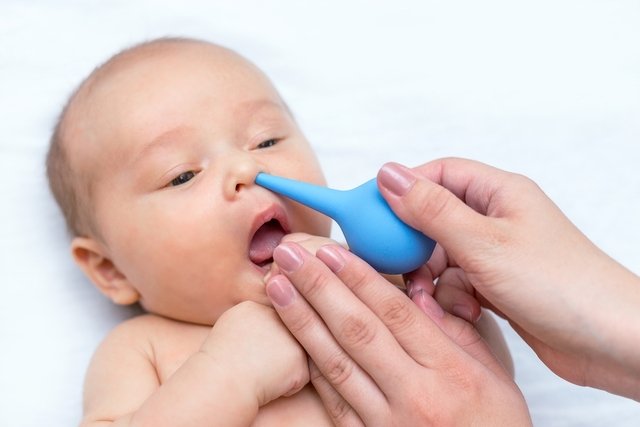Congestion in babies is relatively common, but it can be uncomfortable for the baby. A baby up to 6 months of age can only breathe through their nose, and therefore when their nose becomes plugged, they are forced to work harder to breathe. This can lead to decreased appetite and difficulty gaining weight to grow normally.
To unplug a baby’s nose, you may need certain equipment or materials, like saline drops or a nasal aspirator. Sometimes a warm bath can help to relieve a stuffy nose.
It is important to keep cleaning the baby’s nose throughout the day to remove any discharge. Keeping the nostrils clear can help the baby to feel relief, which can contribute to better sleep quality and appetite.

Home remedies
Ways you can relieve congestion in babies at home include:
1. A warm bath
A warm bath will produce steam that can help to lubricate the nose and eliminate any thicker secretions.
A great tip is to close the bathroom door so that vapor can accumulate in the bathroom. After the bath, it is important to dry the baby well and dress him right away, making sure to avoid any cool breezes soon after.
2. Saline drops
You can apply 3 to 5 ml of saline solution in each nostril, 2 to 3 times per day, to help thin-out secretions. This will help with the natural elimination of secretions.
Another option is to use nasal drops that are specifically for use of clearing nose discharge in babies. These can be purchased at the pharmacy.
3. Aspiration with a bulb syringe
A bulb syringe is similar to a small, pear-shaped pump which can be purchased at the pharmacy. To use it, squeeze the bulb and then insert the tip at the entrance of the baby’s nostril. Then relax the bulb, and secretion with be gently aspirated.
Avoid squeezing the bulb while the bulb syringe is inserted in the baby’s nose, as this can push secretions in deeper into the nostril, making them more difficult to remove.
After using the bulb syringe, be sure to wash it in warm water and soap to prevent fungal or bacterial growth. You should wait for it to dry completely before using it again.
4. Humidifying the room
Place a bowl of warm water in the room where the baby is. This helps to add moisture to the air, which the baby will breathe in, leading to more fluid nasal discharge.
The bowl should be far from the baby’s reach, especially if he or she is crawling or walking.
5. A pillow beneath the mattress
Placing a pillow below the head of the mattress so that the baby can lie down in a slightly elevated position can help the baby to breathe better. This elevation prevents the accumulation of discharge in the throat, which can allow the baby to sleep better.
Main causes of congestion in babies
It is normal for babies to become congested several times in the first months of life, as their immune system is still developing. Although it is not a serious finding in babies, the stuffy nose may need to be treated, as it can be uncomfortable for the baby and interfere with eating and sleeping.
The main causes of a stuffy nose in babies include:
1. Cold or flu
Due to their underdeveloped immune systems, it is normal for babies to experience a cold or flu in the first year of life. Common symptoms of these viral infections include tearing eyes, a stuffy nose and a fever.
What to do: The best way to treat a cold or flu in babies is to breastfeed. In addition, babies over the age of one can consume natural fruit juices, like orange or cherry juice, to help strengthen the immune system and fight the virus faster.
2. Allergies
Allergies, or rhinitis, can arise when the baby comes in contact with dust or fur. Babies can develop sensitivities to irritants and experience sneezing, runny nose and a constant cough.
What to do: You should have the baby avoid the allergen as much as possible and ensure the baby is well-hydrated throughout the day. The child should be assessed by a pediatrician if the allergy is intense and symptoms are frequent.
3. Adenoid growth
The adenoids are a piece of lymphatic tissue located deep within the upper nose. It is a part of the immune system and serves to protect the body from foreign invaders. Adenoid tissue will grow as the baby grows, although it can become excessively swollen and interfere with breathing.
What to do: The child should be assessed by a pediatrician if the baby has noted difficulty with breathing or has constant coughing and a stuffy nose for no apparent reason. The pediatrician can then indicate the best course of treatment.
When to see the doctor
Most times, a stuffy nose is a temporary symptom that is not significant. However, you should have the child assessed if you have any concerns, like if if the baby frequently has congestion or if the baby presents with symptoms like:
- Intense coughing
- Constant sneezing
- Wheezing when breathing
- Decreased appetite
- Fever over 38º C (or 100.4ºF)
- Excessive fatigue
You should proceed immediately to the hospital if the baby is breathing rapidly, or presents with a blue or pale color.
